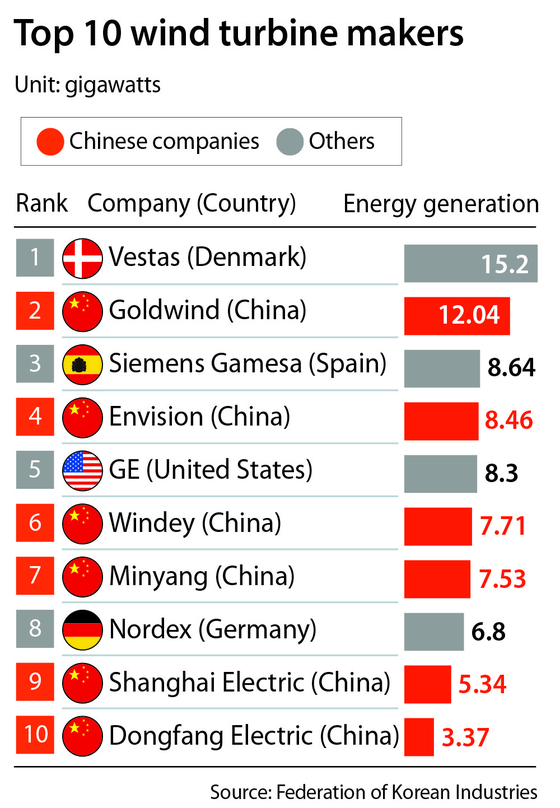China leads market for renewable energy materials

China may take over the renewable energy market and leave Korea in the dust.
China has most of the market share for materials needed to make solar power plants, according to a report released Thursday by the Federation of Korean Industries (FKI).
In 2019, the country held 97 percent of the global market for wafers, a key material used to make solar cells. It held 95 percent of the ingot market, used to process silicon into solar cells.
It also had 79 percent of the cell market, 71 percent of the module market and 63 percent of the polysilicon market, all materials needed for solar power plants.
China is also leading in wind power. As of 2021, six of the top 10 wind turbine manufacturers were Chinese companies.
Although the top spot was taken by Vestas, an Aarhus, Demark-based wind turbine manufacturer, for installing wind turbines that generated 15.2 gigawatts of energy, Chinese companies made up for the majority of the competition. Last year, the total energy generated by wind turbines was 99.2 gigawatts.
No Korean companies appeared on the list.
Although the world is gearing up to use more renewable energy sources, Korean companies are struggling to expand their presence globally. FKI mentioned in its report that increasing tax credits for investments in renewable energy would be necessary for companies to enhance their competitiveness abroad.
To cut down on the usage of fossil fuels, the business lobbying group claimed that Korea needs to increase its usage of nuclear power, of which Korea is also losing its foothold.
China generated 13.5 percent of the world’s nuclear energy in 2020, ranking second, according to data from the International Atomic Energy Agency. The figure was up 6.9 percentage points from 2015, when it ranked fourth.
Korea ranked fifth in terms of nuclear energy generation in 2020, making up for 6 percent of the global output. It fell from the 6.4 percent of 2015, though it maintained the same rank.
President Yoon Suk-yeol has mentioned plans to restore Korea’s nuclear power generation capacity, which was halted during the former Moon Jae-in government under a nuclear phase-out policy. President Yoon announced the government will use 92.5 billion won ($71.4 million) to resume the construction of Shin Hanul units 3 and 4, which has been at a halt since 2017.
One area in which Korea is showing its presence is hydrogen fuel cells, used in hydrogen plants.
In 2019, Doosan Fuel Cell manufactured fuel cells worth 62,040 kilowatts. It was the second biggest fuel cell manufacturer in the world, following Bloom Energy, a California-based manufacturer that made fuel cells worth 92,400 kilowatts.
“Countries like the United States and Britain created a mid- and long-term action plan to develop their hydrogen economy,” said an FKI spokesperson. “Korea also needs to amend restrictions placed on hydrogen energy-related companies and provide support for the development of hydrogen energy technology, allowing businesses to expand abroad.”
BY BAEK IL-HYUN [lee.taehee2@joongang.co.kr]










with the Korea JoongAng Daily
To write comments, please log in to one of the accounts.
Standards Board Policy (0/250자)